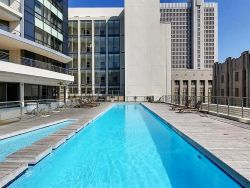Mixed-use developments are no longer an emergent trend in Cape Town - they have become a firmly established feature of the city’s architectural landscape, especially in the CBD, where two more developments are already in the planning stage, and five new proposals are currently on the drawing board.
 Shapiro says mixed-use buildings are a significant element of Sea Point’s ongoing upgrade, with prominent projects including the extensive redevelopment of The Ritz Hotel worth more than R100 million, which includes a new high-end retail component and the old Nedbank Building at the end of Main Road.
Shapiro says mixed-use buildings are a significant element of Sea Point’s ongoing upgrade, with prominent projects including the extensive redevelopment of The Ritz Hotel worth more than R100 million, which includes a new high-end retail component and the old Nedbank Building at the end of Main Road.“The concept really took hold in Cape Town prior to the 2010 world Cup when several mixed-use buildings were constructed in and around the city, including The Mirage on Hudson Street in De Waterkant which was recently voted as the best development in Cape Town, and The Icon Centre in the Foreshore with over 80 apartments, three floors of offices, and a shopping centre on the ground floor,” says Chad Shapiro, Senior Commercial Broker for Lew Geffen Sotheby’s International Realty in the CBD, City Bowl and on the Atlantic Seaboard.
“We are now seeing more of these developments being built along the Atlantic Seaboard in Green Point, Sea Point and the V&A Waterfront, as well as in Vredehoek in the City Bowl.”
Shapiro says mixed-use buildings are a significant element of Sea Point’s ongoing upgrade, with prominent projects including the extensive redevelopment of The Ritz Hotel worth more than R100 million, which includes a new high-end retail component and the old Nedbank Building at the end of Main Road.
“We have seen that the real estate sector as a whole has benefited from the balanced combination of fixed and variable tenants who are increasingly less dependent on location and tourism.”
Brendan Miller, Lew Geffen Sotheby’s International Realty Atlantic Seaboard and City Bowl CEO, says mixed-use developments offer a cornucopia of benefits to both residents and businesses, not least the convenience of everything in one place that is an increasingly appealing factor to buyers.
 This two bedroom, two bathroom apartment located in the highly sought-after and secure Mandela Rhodes building is light, bright and has access to a large pool. It is on the market for R2.995 million - click here to view.
This two bedroom, two bathroom apartment located in the highly sought-after and secure Mandela Rhodes building is light, bright and has access to a large pool. It is on the market for R2.995 million - click here to view.“Cape Town’s swelling population has exacerbated traffic congestion during peak hours, significantly extending commuting time between the city and the suburbs, and people are no longer willing to spend hours in a car every day,” says Miller.
“Instead, people can live, work and play in one neighbourhood as they are within walking distance of myriad amenities, including their places of work.”
Miller says many of these properties also cater to residents’ essential needs by incorporating retail components, restaurants and gym facilities, and often also offices.
Lew Geffen, Chairman of Lew Geffen Sotheby’s International Realty, says an increasing number of Capetonians are beginning to recognise the value of exchanging their suburban homes for the convenience of city living.
He says correctly priced apartments are, almost without exception, snapped up within four to six weeks of being listed.
“The growing investor confidence is further evidenced by the fact that some developers are now renting out new fully-furnished apartments in anticipation that the value of these properties will continue to grow exponentially, underpinned by a strong rental market,” says Geffen.
“For many years, the price point for residential property on The Atlantic Seaboard was a lot higher than in the City Bowl and CBD, but this gap has narrowed considerably in recent years, with city pricing now almost in line with that of Sea Point and Green Point,” says Shapiro.
Cape Town Central City Improvement District (CCID) statistics from a survey conducted in the last quarter of 2015 revealed that owner-occupied residential properties in the CBD increased from 47% in 2014 to 52% in 2015, while 73% of the survey respondents lived within 3km of their work or place of study.
Rob Kane, Chairperson of the CCID, says although city residents still fall primarily within the 25 to 34 age group, there has recently been a notable spike in interest from investors in the 35 to 44 year age bracket.
The survey further established that the top reason cited for living in the CBD is proximity to work, and the top category of profession among those surveyed this year is media, marketing and publishing, followed by creative industries and the financial sector.
“We are constantly looking for stand-alone homes in these areas that have commercial rights, or that offer subdivision to meet the rampantly growing demand for residential and commercial development in these prime areas,” says Shapiro.








